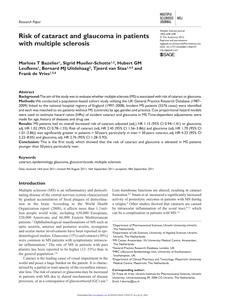The aim of the study was to evaluate whether multiple sclerosis (MS) is associated with risk of cataract or glaucoma. We conducted a population-based cohort study utilizing the UK General Practice Research Database (1987–2009) linked to the national hospital registry of England (1997–2008). Incident MS patients (5576 cases) were identified and each was matched to six patients without MS (controls) by age, gender, and practice. Cox proportional hazard models were used to estimate hazard ratios (HRs) of incident cataract and glaucoma in MS. Time-dependent adjustments were made for age, history of diseases and drug use.

Learning environment designs at the boundary of school and work can be characterised as integrative because they integrate features from the contexts of school and work. Many different manifestations of such integrative learning environments are found in current vocational education, both in senior secondary education and higher professional education. However, limited research has focused on how to design these learning environments and not much is known about their designable elements (i.e. the epistemic, spatial, instrumental, temporal and social elements that constitute the learning environments). The purpose of this study was to examine manifestations of two categories of integrative learning environment designs: designs based on incorporation; and designs based on hybridisation. Cross-case analysis of six cases in senior secondary vocational education and higher professional education in the Netherlands led to insights into the designable elements of both categories of designs. We report findings about the epistemic, spatial, instrumental, temporal and social elements of the studied cases. Specific characteristics of designs based on incorporation and designs based on hybridisation were identified and links between the designable elements became apparent, thus contributing to a deeper understanding of the design of learning environments that aim to connect the contexts of school and work.
LINK
Individuals with mild intellectual disabilities or borderline intellectual functioning are at increased risk to develop a substance use disorder—however, effective treatment programs adapted to this target group are scarce. This study evaluated the effectiveness of Take it Personal!+ in individuals with mild intellectual disabilities or borderline intellectual functioning and substance use disorder. Take it Personal!+ is a personalized treatment based on motivational interviewing and cognitive-behavioral therapy supported by an mHealth application. Data were collected in a nonconcurrent multiple baseline single-case experimental design across individuals with four phases (i.e., baseline, treatment, posttreatment, and follow-up). Twelve participants were randomly allocated to baseline lengths varying between 7 and 11 days. Substance use quantity was assessed during baseline, treatment, and posttreatment with a daily survey using a mobile application. Visual analysis was supported with statistical analysis of the daily surveys by calculating three effect size measures in 10 participants (two participants were excluded from this analysis due to a compliance rate below 50%). Secondary, substance use severity was assessed with standardized questionnaires at baseline, posttreatment, and follow-up and analyzed by calculating the Reliable Change Index. Based on visual analysis of the daily surveys, 10 out of 12 participants showed a decrease in mean substance use quantity from baseline to treatment and, if posttreatment data were available, to posttreatment. Statistical analysis showed an effect of Take it Personal!+ in terms of a decrease in daily substance use in 8 of 10 participants from baseline to treatment and if posttreatment data were available, also to posttreatment. In addition, data of the standardized questionnaires showed a decrease in substance use severity in 8 of 12 participants. These results support the effectiveness of Take it Personal!+ in decreasing substance use in individuals with mild intellectual disabilities or borderline intellectual functioning.
